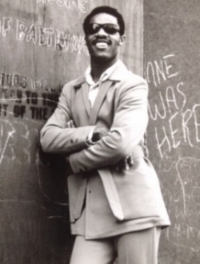Hail, Stevie, and (of course) happy birthday
Lee and Sylvia help him to leave 'Little' behind
May 13 is Stevie Wonder’s birthday, while May 18 marks the original release, fifty years ago, of “I Was Made To Love Her.” In celebration of both dates, and in recognition of Sylvia Moy, who died last month, here’s the story of that hit. It’s adapted from the tale told in The Billboard Book of Number One Rhythm & Blues Hits. The song’s writers were Stevie, Sylvia and Henry Cosby; also credited is Stevie’s mother, Lula Mae Hardaway. Cosby produced the record.
Stevie Wonder was 16 when he cut “I Was Made To Love Her” in March 1967, and it showed. Maturing as a vocalist, he was evidently becoming more comfortable with lyrics of love. “He began to take more of an active part with the vocal melody and the lyric,” Sylvia Moy explained.
Moy was co-writer of three of Wonder’s Top 10 R&B hits in ’66: “Uptight (Everything’s Alright),” “Nothing’s Too Good For My Baby” and “With A Child’s Heart.” She said, “Stevie began to grow and grow, which was very fortunate, and he began to find out more about himself, which was very good.”
In writing lyrics for “I Was Made To Love Her,” Moy drew from her own family background. “The song was really about my mom and dad,” she said. “My mother was from Arkansas, and it was based on stories I heard from them. Stevie just locked right into it – but then creative people are so sensitive, you can express a story to them and they can absorb it.”
Henry Cosby may have helped Wonder to absorb something else for “I Was Made To Love Her.” By one account, Cosby took him to a Baptist church in Detroit to hear the preacher’s shouting and screaming, hoping the teenager would be influenced – as apparently he was – to imitate that fever pitch for his own singing.
When he was laying down vocal tracks, added Moy, Wonder wanted company. “I guess it was his blindness. With other singers, you’d have to put people out of the studio, because it would get ridiculous and you’d never get the vocals done. But Stevie was different, he had to feel the presence of people. If there were none around, his vocal was just dead. Oft times, I had to go outside and just stop people who were passing to bring them in [to the studio], so Stevie could feel their presence. Once we got that, he could fire into that feeling.”
“I Was Made To Love Her” was also notable for Wonder’s front-and-centre harmonica work. He had been downplaying the instrument – or so it appeared – while striving to shed his “Little” Stevie Wonder identity, so this record marked its full reinstatement.
“He was getting very tired of the ‘Little Stevie Wonder’ thing,” confirmed songwriter and recording artist Lee Garrett, who first met the musician at the Michigan School for the Blind and later collaborated with him on “Signed, Sealed, Delivered, I’m Yours” and “Let’s Get Serious.”
Stevie and Barney in London, 1966
“I remember one time in particular,” continued Garrett. “We were doing a show together, and the MC called out, ‘Little Stevie Wonder.’ Stevie exploded: ‘Little! Little! Little Stevie Wonder! I’m not going on that fucking stage, I’m not Little Stevie Wonder!’ I put my hand on Stevie’s shoulder, and said, ‘That’s OK, you’ve got to let them grow out of it’.”
Let’s close with greetings to one of Motown’s backroom believers, Barney Ales, who shares the May 13 birthdate with Stevie. During his many years at the company, Barney and his promotion footsoldiers helped Wonder to achieve chart success and global superstardom. And, in 1976, Barney re-signed Stevie to Motown, clearing the path for the release of perhaps his greatest album, Songs In The Key of Life.
To both these May 13 magicians, many happy returns.


